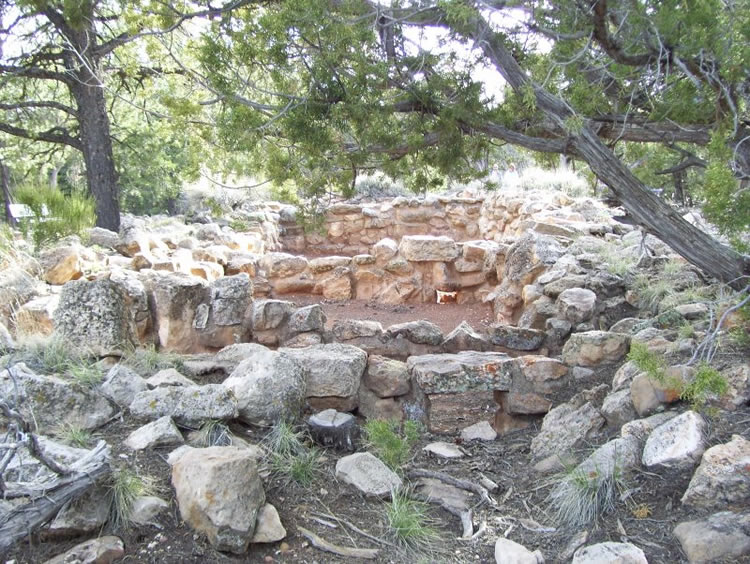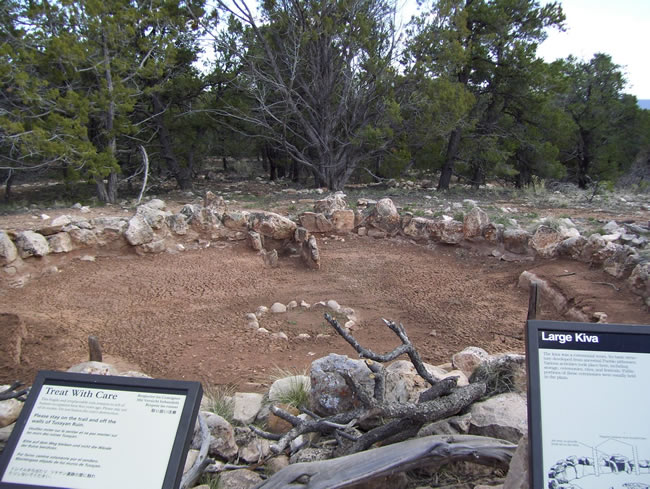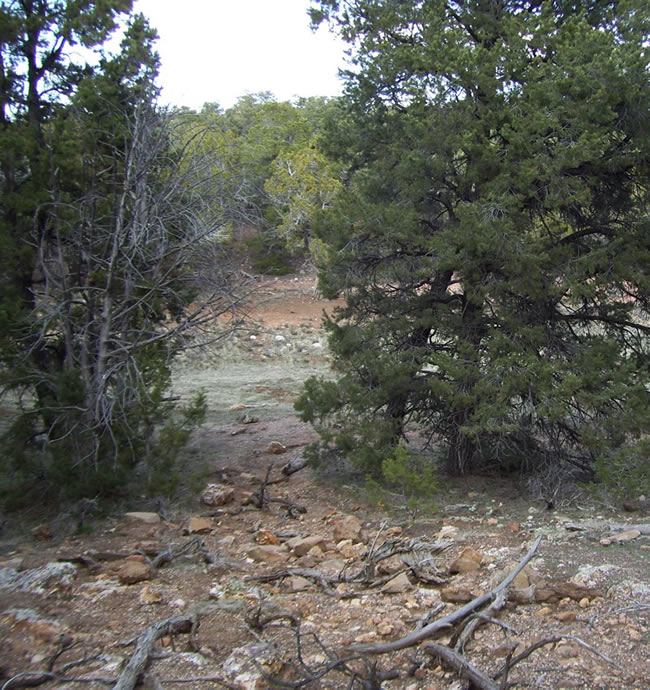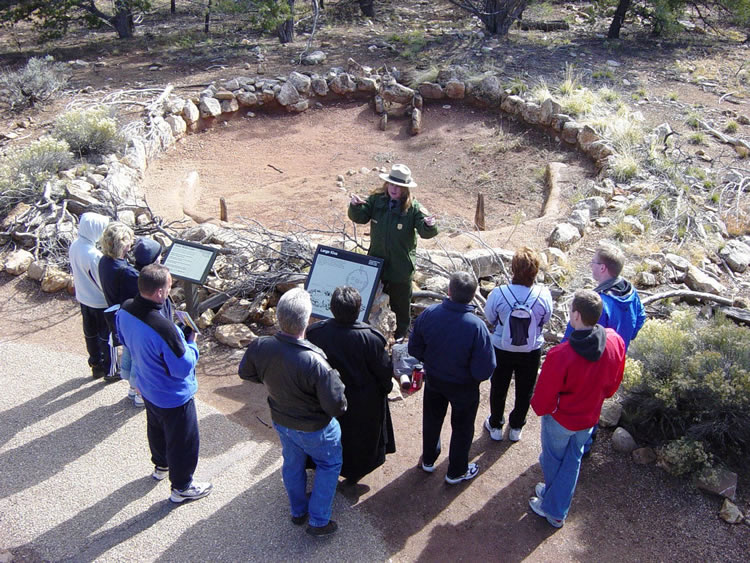Most people, when they first hear the words “Grand Canyon,” envision a wilderness area with spectacular rock formations that tell an important geological story. Few people realize that humans have continuously occupied the Grand Canyon for at least the past 4,000 years, and that humans have lived in the region for the past 12,000 years. Reflecting this long period of habitation, the Grand Canyon has been the site of important archaeological discoveries that tell the long story of human life in North America. So far, the National Park Service (NPS) has only intensively surveyed 3% of the park area, but they have already documented 4,800 archaeological sites, meaning many more remain to be cataloged. The Park Service interprets this long human history of the Grand Canyon to visitors primarily at the Tusayan Ruin and Museum near the eastern end of the park.
Over the centuries humans have come and gone in and around the Grand Canyon area, sometimes occupying the Canyon for extended periods of time, other times staying only briefly. One group that established roots at the Grand Canyon were the Ancestral Puebloans, who are believed to be relatives of the modern day Hopi, Zuni, and other Puebloan tribes. Ancestral Puebloans used juniper trees as the main beams in their dwellings, which now allows tree-ring researchers to determine the age of the dwellings by comparing tree rings in these beams to data they have of tree growth over many centuries in the area. This tree ring dating shows that Ancestral Puebloans developed what is now known as the Tusayan settlement a few miles from the southern edge of the Grand Canyon around 1185 A.D. They established homes, agricultural fields, communal buildings, and religious structures that have revealed to archeologists a great deal about ancient life in this area 800 years ago.
The settlement featured a central plaza surrounded by storage rooms, living quarters, and kivas. The plaza faced south to catch the sun in the cooler seasons. The living quarters consisted of a single story of rock, adobe, and wood with about 3 or four main rooms. Storage rooms held food that was dried to preserve it during harsh winter months.
The site also contains the ruins of two kivas, or ceremonial structures, that modern Puebloans still use today in religious ceremonies and festivals. They are believed to represent a geological feature on the floor of the Grand Canyon, known as the Sipapuni, that many Hopi believe is the place where they entered into this world. Kivas are circular in shape, often below ground, and accessed by a ladder through a hole in the roof. However, the Kaibab Limestone in this area prevented ancient people from digging very far into the ground to build their kivas.
Even though the climate was a little cooler and wetter during the heyday of the Tusayan settlement 800 years ago, the area was still predominantly arid and the soil poor for agriculture. It was hard for humans to survive, especially in a permanent settlement, because it was easy to quickly use up nearby resources. Residents planted crops of corn, beans, and squash in a small wash nearby. They supplemented this food supply with wild game and plants such as yucca, pinyon nuts, berries, and different types of cactus. The lack of water sources on the South Rim, a factor that plagues Grand Canyon National Park even today, was a significant deterrent to a larger, more permanent settlement. This small group of Ancient Puebloans abandoned their Grand Canyon home only 25 or 30 years after they first settled there.
With NPS permission, archaeologists from Gila Pueblo in Globe, Arizona, excavated the site in 1930. The group pledged to build a museum nearby to interpret the site, and agreed that at least half of any artifacts they uncovered would remain at the Grand Canyon. Originally named the Wayside Museum of Archaeology, the Tusayan Museum is now a small, square, two-room building made mostly of stone with some wooden beams. It looks like it could have blended in seamlessly with the Puebloan settlement 800 years ago.
Despite the outside money used to build the museum, NPS interpretive personnel designed the exhibits and staffed the site. It opened in 1932, the same year as the Fred Harvey Company opened the nearby Desert View Watchtower, a faux-Native American structure. Over the years, when it came time to spend money on exhibits or repairs, it was rarely high on the NPS list of priorities because most early administrators saw Grand Canyon National Park primarily as a natural park, not a historical or archaeological park. Even when visitation to the museum far exceeded their expectations, administrators still tended to see the site as having at most secondary importance in interpretive and management plans.
Whereas Yavapai Observation Station told the geological story of the Canyon, the NPS intended this museum to show human history. Early exhibits focused mostly on the life and culture of ancient Native American tribes, portraying them rather romantically as a mysterious, vanished race.
Today, exhibits cover both the archaeological and modern history of five major tribes associated with the Grand Canyon (the Havasupai, Hopi, Hualapai, Navajo, and Paiute), emphasizing their enduring, strong cultural connections to the area. One of the most significant exhibits is a display of split twig figurines dating back 2,000 to 4,000 years. Though they were not found at Tusayan Ruin itself, these figurines collected from caves in the Grand Canyon speak to the long human presence at the Grand Canyon and its use by Native Americans.
Visitors to the site can take a self-guided tour around the ruins, enjoy daily interpretive ranger talks there, or meander through the small museum. Anyone who encounters any archaeological site at the Canyon is encouraged to leave it undisturbed and report it to the National Park Service immediately so that archaeologists can document, study, and preserve it for future generations.
Written By Sarah Bohl Gerke
References:
- Anderson, Michael. Polishing the Jewel: An Administrative History of Grand Canyon National Park. GCA, 2000.
- Shields, Kenneth Jr. The Grand Canyon: Native People and Early Visitors. Charleston, SC: Arcadia Publishing, 2000.







